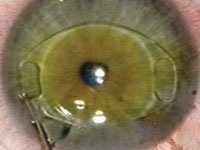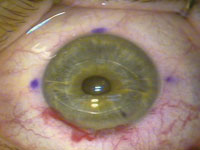Early experience with Verisyse is promising
Until now, one group of patients has been underserved by safe and effective vision correction surgery. High myopes who are so nearsighted that LASIK cannot meet their refractive error can now benefit from the predictable, safe and effective Verisyse/Artisan phakic IOL (Ophtec USA/Advanced Medical Optics).
The following case report is about a high myope who was told he could not have LASIK.
Problems with soft lenses
WR was 32 years old in fall of 2001 when he was told his soft contacts were causing corneal problems. He decided to pursue LASIK with Dr. Foote. His corneal thickness was a promising 599 µm in the right eye and 603 µm in the left eye. His manifest refraction yielded a spherical equivalent of –13.75 D in the right eye and –17.12 D in the left eye. He had 1 D of astigmatism in both eyes, but no other ocular or systemic health issues. WR was told to not consider LASIK, but rather to wait for some future technologies we expected to become available.
The Verisyse lens was approved by the Food and Drug Administration in the fall of 2004 for myopes in the range of –5.00 D to –20.00 D. We contacted WR and told him this may be an option.
During WR’s preoperative evaluation, we determined that he had both an adequate endothelial cell count and anterior chamber depth to consider him a candidate for the Verisyse implant in both eyes. Adequate endothelial cell count is considered to be 2,000 cells/mm2, and adequate anterior chamber depth is at least 3.2 mm. After informed consent, he scheduled surgery immediately. As an added measure of safety, we had him screened by our retinal specialist and cleared for the Verisyse implant.
Lens selection
|
|
The lens selection for Verisyse is straightforward. AMO provides a lens calculation program that can be easily loaded on a computer. The patient’s manual K readings, along with his or her refraction in plus cylinder form and the vertex distance, were input into the software template. The software then computed the best lens pick for an emmetropic outcome. We selected the implant power that theoretically would leave WR with a –0.22-D result in the right eye and a –0.16-D result in the left eye.
Verisyse implantation was performed in the left eye first and in the right eye 5 days later. The surgical implantation of the Verisyse lens was straightforward, and no complications occurred with either procedure.
During the wet lab at the AMO Verisyse surgical course, the instructors said it would be easier to implant the lens in a live patient than it was in the practice eyes. They were correct. Every surgery we have done since has been easier than working on those cadaver eyes. The learning curve was not as difficult as we expected, and the joy our patients feel after surgery is immeasurable.
Postoperative vision
In less than 1 week, WR changed from 20/count fingers at 1 foot to 20/25 in both eyes. Other than a slight sensitivity to light, which subsequently diminished, WR had “great” vision and no discomfort. His eyes remained quiet during the 3-week postoperative drop period.
The postoperative therapeutic regiman was Zymar (gatifloxacin, Allergan), one drop four times daily for a week, and one drop each of Pred Forte (prednisolone acetate, Allergan) and Acular (ketorolac tromethamine, Allergan) for 3 weeks, then tapered as needed.
The Verisyse implant in the right eye was centered very well, and the implant in the left eye was positioned slightly inferiorly. We wondered how critical it would be to have the implant right on center with regard to the pupil. This lens is very forgiving in the patient’s quality of vision. “I see great both in the day and at night. If I close my right eye, I can see a little halo partially around lights, but with both eyes open, it’s gone,” he said.
WR sees well, and I liken the vision with a Verisyse to that of a gas-permeable contact lens. GP contacts seldom center perfectly on a patient’s cornea, yet patients report excellent vision. WR has Verisyse implants that are positioned close enough to his visual axis to provide him with the best vision of his life without glasses or contact lenses.
His postoperative vision improved to 20/20- in both eyes at 2 weeks postop. At 2 months postop, he is 20/20–2 in his right eye with a plano spherical manifest refraction, and he is 20/20–1 in his left eye with a plano +0.25 × 025 manifest refraction. He was 20/20–2 best-corrected in both eyes before surgery. The sutures are non-dissolvable, but remain buried under the conjunctiva and do not need to be removed.
WR is just one example of a person whose quality of life has vastly improved. The quality of vision that Verisyse brings to the table is, in our experience, superior to that of LASIK.
For Your Information:
- Peter S. Foote, MD, is the medical director of Milwaukee Eye Care and Foote Laser Vision in Milwaukee.
- Jay A. Heilmann, OD, is an optometrist in the same practice who specializes in the comanagement of surgical vision correction patients. He can be reached at 1684 N. Prospect Ave., Milwaukee, WI 53202; (414) 271-2020; fax (414) 272-3932. Drs. Foote and Heilmann have no direct financial interest in the products mentioned in this article, nor are they paid consultants for any companies mentioned.
- The Verisyse lens is available from Advanced Medical Optics, 1700 E. St. Andrew Place, PO Box 25162, Santa Ana, CA 92799-5162; (714) 247-8200; Web site: www.amo-inc.com.


